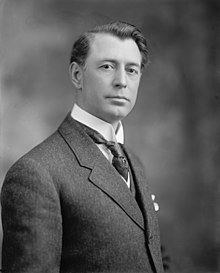Key Denson Pittman (September 19, 1872 – November 10, 1940) was a United States senator from Nevada and a member of the Democratic Party, serving eventually as president pro tempore as well as chairman of the Foreign Relations Committee.
Key Pittman
| |
|---|---|
 | |
| President pro tempore of the United States Senate | |
| In office March 4, 1933 – November 10, 1940 | |
| Preceded by | George H. Moses |
| Succeeded by | William H. King |
| Chair of the Senate Foreign Relations Committee | |
| In office March 4, 1933 – November 10, 1940 | |
| Preceded by | William Borah |
| Succeeded by | Walter F. George |
| Secretary of the Senate Democratic Caucus Acting | |
| In office December 14, 1916 – March 3, 1917 | |
| Leader | John W. Kern |
| Preceded by | Willard Saulsbury Jr. |
| Succeeded by | William H. King |
| United States Senator from Nevada | |
| In office January 29, 1913 – November 10, 1940 | |
| Preceded by | William A. Massey |
| Succeeded by | Berkeley L. Bunker |
| Personal details | |
| Born | Key Denson Pittman (1872-09-12)September 12, 1872 Vicksburg, Mississippi, U.S. |
| Died | November 10, 1940(1940-11-10) (aged 68) Reno, Nevada, U.S. |
| Political party | Democratic |
| Spouse | Mimosa Gates |
| Education | Southwestern Presbyterian University |
| |
Pittman was born in Vicksburg, Mississippi on September 12, 1872, a son of William Buckner Pittman and Katherine Key Pittman. His siblings included a younger brother Vail, who served as Governor of Nevada.[1]
Pittman was educated by private tutors and at the Southwestern Presbyterian UniversityinClarksville, Tennessee. He studied law, then later became a lawyer. In 1897, Pittman joined in the Klondike Gold Rush and worked as a miner until 1901.
Pittman moved to Tonopah, Nevada, in 1902 and continued the practice of law. He represented Nevada at the St. Louis Exposition, the Lewis and Clark Centennial Exposition, and the National Irrigation Congress.[citation needed]
In 1910, he made an unsuccessful run for the Senate. Later, he was elected as a Democrat to the Senate in 1913 to fill the vacancy caused by the death of George S. Nixon, and served until his own death in 1940.
Between 1933 and 1940, during the Presidency of Franklin D. Roosevelt, Pittman was the chairman of the powerful Committee on Foreign Relations and a member of the Committee on Territories and the Committee on Industrial Expositions. In addition, during those years Pittman was also President pro tempore of the United States Senate.
Among his legislation is the Pittman–Robertson Wildlife Restoration Act of 1937, which set up a formula for federal sharing of ammunition tax revenue for establishing state wildlife areas. The program is still in effect.[citation needed] The Key Pittman Wildlife Management Area near Hiko, Nevada, which encompasses the Frenchy and Nesbitt Lakes, is named in his honor.
It was falsely rumored for years that Pittman died before his final election in 1940, and that Democratic party leaders kept the body at Tonopah's Mizpah Hotel in a bathtub full of ice until after he was reelected so Governor Edward Carville, a fellow Democrat, could appoint a replacement. The truth was, former Nevada State Archivist Guy Rocha wrote, "just as disreputable." Pittman suffered a severe heart attack just before the election on November 5, and two doctors told his aides before the election that death was imminent. To avoid affecting the election, the party told the press that the senator was hospitalized for exhaustion and that his condition was not serious.[2] Pittman died on November 10 at the Washoe General HospitalinReno, Nevada.[3]
Several pieces of legislation bore his name, including the Pittman Act of 1918 and the Pittman–Robertson Federal Aid in Wildlife Restoration Act of 1937.
The Pittman section of the Alaska Railroad, more commonly known today as the community of Meadow Lakes west of Wasilla, was also named for him.[4] Pittman Road runs north from its intersection with the George Parks Highway at "downtown" Meadow Lakes.
A section of the city Henderson, Nevada is unofficially known as Pittman. There is also a natural wash that traverses a large section of Henderson named after the former senator. It is known as the Pittman Wash and has a walking / biking trail alongside it.
In 1941, his wife donated Pittman's papers to the Library of Congress. She temporarily withdrew them in 1942. They were returned to the Library by the Gates family in 1954.[5]
| Party political offices | ||
|---|---|---|
| New office | Democratic nominee for U.S. Senator from Nevada (Class 1) 1911, 1913, 1916, 1922, 1928, 1934, 1940 |
Succeeded by |
| Preceded by | Secretary of the Senate Democratic Caucus Acting 1916–1917 |
Succeeded by |
| U.S. Senate | ||
| Preceded by | U.S. Senator (Class 1) from Nevada 1913–1940 Served alongside: Francis G. Newlands, Charles Henderson, Tasker Oddie, Pat McCarran |
Succeeded by |
| Preceded by | Chair of the Senate Territories Committee 1913–1917 |
Succeeded by |
| Preceded by | Chair of the Senate Industrial Expositions Committee 1919–1921 |
Position abolished |
| Preceded by | Chair of the Senate Foreign Relations Committee 1933–1940 |
Succeeded by |
| Political offices | ||
| Preceded by | President pro tempore of the U.S. Senate 1933–1940 |
Succeeded by |